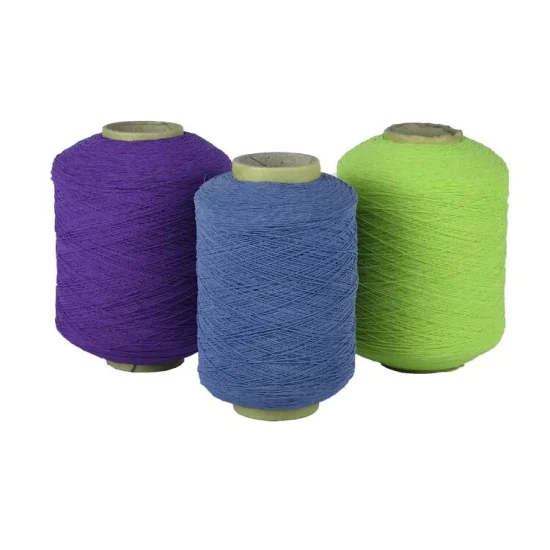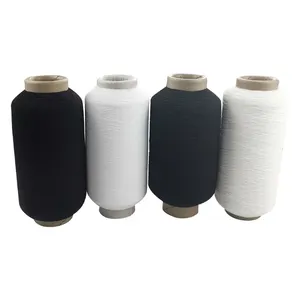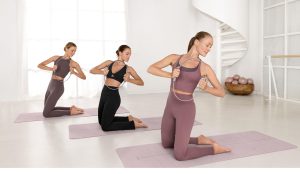Covered elastic yarn stands at the forefront of textile innovation, bridging the gap between functionality and fashion in ways previously unimaginable. This remarkable material, with its unique composition and properties, has become an indispensable component in the creation of high-performance garments and specialized textiles. As we delve into the intricacies of elastic yarn, we’ll uncover its profound impact on the textile industry and explore the myriad applications that are shaping the future of fabric technology.
The Anatomy of Covered Elastic Yarn: Unraveling Its Composition

At the heart of elastic yarn lies a marvel of engineering that combines elasticity with durability. This section will explore the intricate structure and components that make this yarn a game-changer in textile manufacturing.
The core of covered elastic yarn is typically made from materials known for their exceptional stretch properties, such as spandex or rubber. This elastic core is then meticulously wrapped with one or more layers of other fibers, creating a composite yarn that marries flexibility with strength. Let’s delve deeper into the elements that constitute this revolutionary yarn.
The Elastic Core: The Heart of Flexibility
The elastic core is the soul of covered yarn, providing the stretch and recovery that define its performance.
Spandex, also known by the brand name Lycra, is a synthetic fiber renowned for its incredible elasticity. It can stretch up to 500% of its original length and snap back to shape without losing its properties. This makes it an ideal choice for the core of covered yarn used in form-fitting garments and activewear.
Rubber, another common core material, offers high elasticity and resilience. Natural rubber, derived from the latex of certain trees, has been used for centuries in various applications. Its incorporation into covered elastic yarn provides a more eco-friendly option for manufacturers looking to reduce their environmental impact.
The Outer Covering: Strength and Aesthetics Combined
The covering fibers play a crucial role in determining the final characteristics of the yarn, influencing everything from appearance to durability.
Nylon, a synthetic polymer known for its strength and abrasion resistance, is often used as a covering fiber. It enhances the yarn’s durability while maintaining a smooth surface, making it ideal for applications where the yarn may be subject to frequent friction.
Polyester, another popular choice for covering, offers excellent color retention and resistance to wrinkles and shrinking. This makes it particularly suitable for sportswear and swimwear, where vibrant colors and shape retention are crucial.
Cotton, a natural fiber, provides breathability and comfort when used as a covering. It’s often chosen for yarns intended for everyday wear or undergarments, where skin comfort is paramount.
The Covering Process: Air vs. Mechanical
The method used to apply the covering fibers to the elastic core significantly impacts the yarn’s properties and performance.
Air-covering involves using high-pressure air to wrap the covering fibers around the core. This process results in a yarn with a softer feel and greater flexibility, as the covering fibers are less tightly bound to the core. Air-covered yarn is often preferred for applications requiring maximum stretch and comfort.
Mechanical covering, on the other hand, uses traditional spinning methods to wrap the covering fibers around the core. This process typically produces a yarn with a more uniform appearance and potentially greater durability, but it may sacrifice some of the softness and stretch achieved through air-covering.
Applications Across Industries: From Fashion to Function

Covered elastic yarn has found its way into an astonishing array of products, revolutionizing multiple industries with its unique properties. This section will explore the diverse applications of this versatile material, showcasing its impact on everything from high-fashion runways to medical devices.
The adaptability of covered yarn has made it a favorite among designers and engineers alike, enabling the creation of products that combine aesthetic appeal with unparalleled functionality. Let’s examine some of the key industries that have been transformed by the introduction of this innovative material.
Fashion Forward: Redefining Comfort and Style
In the world of fashion, covered elastic yarn has become synonymous with comfort and form-fitting design.
High-end lingerie and shapewear have been revolutionized by the introduction of covered elastic yarn. These garments now offer unprecedented levels of support and comfort, contouring to the body’s curves without sacrificing breathability or aesthetics. Designers can create pieces that smooth and shape while remaining virtually invisible under clothing, a feat that was once thought impossible.
Activewear and athleisure have perhaps benefited the most from covered yarn technology. From yoga pants to compression shirts, these garments leverage the yarn’s stretch and recovery properties to provide unrestricted movement and muscle support. The ability to wick moisture and maintain shape even after repeated use has made covered elastic yarn an essential component in the creation of high-performance athletic wear.
Medical Marvels: Supporting Health and Recovery
The medical field has embraced covered elastic yarn for its ability to provide targeted support and compression.
Compression garments, used in the treatment of various circulatory and lymphatic conditions, rely heavily on covered elastic yarn. These specialized garments apply consistent pressure to specific areas of the body, promoting blood flow and reducing swelling. The precise control over compression levels afforded by covered elastic yarn has greatly improved the efficacy of these treatments.
Orthopedic supports and braces have also been enhanced by the incorporation of covered yarn. Knee braces, ankle supports, and back braces now offer a combination of flexibility and support that was previously unattainable. Patients can maintain a greater range of motion while receiving the necessary support for their injuries or chronic conditions.
Industrial Innovation: Strength and Flexibility Combined
Beyond fashion and medicine, covered elastic yarn has found applications in various industrial settings.
Automotive interiors have been transformed by the use of covered yarn in seat covers and headliners. The material’s ability to conform to complex shapes while maintaining durability has led to more comfortable and longer-lasting vehicle interiors.
Aerospace applications have also benefited from covered yarn technology. In-flight comfort has been improved through the development of more ergonomic seating materials, while the yarn’s strength-to-weight ratio has made it valuable in certain specialized components.
The Future of Covered Elastic Yarn: Innovations on the Horizon
As we look to the future, the potential for covered yarn continues to expand, driven by ongoing research and technological advancements. This section will explore emerging trends and potential innovations that could further revolutionize the textile industry.
The evolution of covered yarn is closely tied to advancements in material science and manufacturing processes. As new technologies emerge, we can expect to see even more impressive applications for this versatile material. Let’s examine some of the exciting developments on the horizon.
Smart Textiles: The Integration of Technology
The intersection of covered elastic yarn and smart technology is opening up new frontiers in wearable tech.
Conductive covered elastic yarn is being developed to create garments that can monitor vital signs and transmit data wirelessly. This technology could revolutionize healthcare by allowing for continuous, non-invasive patient monitoring. Imagine a compression sleeve that not only provides support but also tracks muscle activity and recovery in real-time.
Temperature-regulating covered yarn is another area of active research. By incorporating phase-change materials into the yarn’s structure, scientists are working to create fabrics that can actively respond to environmental conditions, keeping wearers comfortable in a wide range of temperatures.
Sustainable Solutions: Eco-Friendly Alternatives
As environmental concerns become increasingly pressing, the textile industry is exploring more sustainable options for covered elastic yarn.
Bio-based elastic cores are being developed as alternatives to traditional synthetic materials. These cores, derived from renewable resources such as corn or sugarcane, offer similar performance to their petroleum-based counterparts while reducing the carbon footprint of textile production.
Recycled covering fibers are gaining traction as a way to reduce waste in the textile industry. By incorporating recycled polyester or nylon into the covering process, manufacturers can create high-performance yarns with a lower environmental impact.
Enhanced Performance: Pushing the Boundaries
Ongoing research is focused on improving the already impressive properties of covered elastic yarn.
Ultra-high stretch yarns are being developed to meet the demands of extreme sports and specialized medical applications. These yarns aim to provide even greater elasticity and recovery, allowing for the creation of garments that can withstand unprecedented levels of stress and strain.
Antimicrobial covered elastic yarn is another area of innovation, particularly relevant in light of recent global health concerns. By incorporating antimicrobial agents into the yarn’s structure, researchers hope to create textiles that can actively resist the growth of harmful bacteria and viruses.
Conclusion: Weaving the Future of Textiles
As we’ve explored the world of covered elastic yarn, it’s clear that this innovative material has already left an indelible mark on the textile industry. From its complex structure to its diverse applications across fashion, medicine, and industry, covered elastic yarn has proven to be a true game-changer in the world of fabrics.
The future of covered elastic yarn looks brighter than ever, with ongoing research promising even more exciting developments. As we continue to push the boundaries of what’s possible in textile engineering, we can expect to see covered elastic yarn at the forefront of innovation, driving the creation of smarter, more sustainable, and higher-performing materials.
In an era where the demand for functional, comfortable, and environmentally responsible textiles is at an all-time high, covered elastic yarn stands as a testament to human ingenuity and the power of technological advancement. As we look to the future, it’s clear that this remarkable material will continue to shape the way we think about and interact with the fabrics in our lives, weaving a future that is both flexible and strong.
{done



